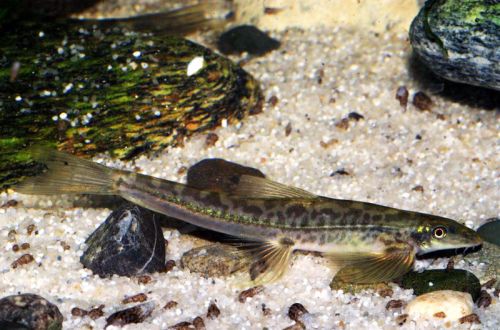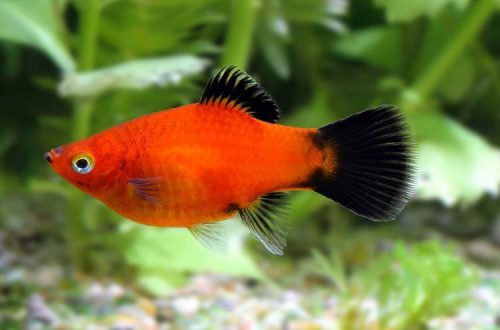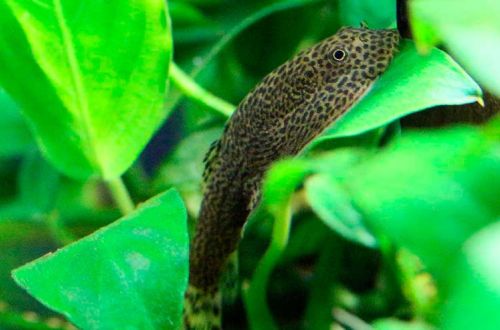
Bedotsia Madagascar
Bedotia Madagascar or Red-tailed Bedotia, scientific name Bedotia madagascariensis, belongs to the Bedotiidae family. This species appeared in amateur aquariums relatively recently – since the 1950s, but has already gained popularity in Europe and America due to its beautiful coloration, ease of maintenance and compatibility with representatives of other fish families.
Contents
Habitat
Endemic to the island of Madagascar, found exclusively in the eastern part in small streams and lower reaches of rivers flowing into lagoons and coastal lakes. Prefers regions with a slow current, dense aquatic and coastal vegetation. All habitats are characterized by very soft and acidic water, which, due to the abundance of tannins, has acquired a tea shade. Juveniles stay on the shallows near the shore, while adult fish, gathering in a flock, are at depth.
Currently, in a number of habitats, Bedocia has been replaced by invasive species, such as the Gambusia, which was introduced to the island as a biological control agent for blood-sucking insects (malarial mosquitoes).
Brief information:
- The volume of the aquarium – from 100 liters.
- Temperature – 23-32°C
- Value pH — 4.5–7.5
- Water hardness – soft to medium hard (1-15 dGH)
- Substrate type – any
- Lighting – subdued
- Brackish water – no
- Water movement is weak
- The size of the fish is 8–10 cm.
- Meals – mostly meat
- Temperament – peaceful
- Keeping a flock of at least 8-10 individuals
Description
Adults reach a length of about 10 cm. Males have a brighter and more varied color compared to females. The body is gray with a yellow or blue tint, the fins and tail combine several colors at once – yellow, black and red.
Food
In nature, it feeds on insects and other invertebrates, so in a home aquarium it is also desirable to give preference to a protein diet. For example, regularly feed bloodworms, brine shrimp, and daphnia, along with a daily portion of dry quality food.
Maintenance and care, arrangement of the aquarium
The recommended volume of the aquarium for a small flock starts from 100 liters. The design is arbitrary, however, it is noted that the closer it is to natural conditions, the richer the color of the fish. You can use dense clusters of floating and rooting vegetation, various snags in the form of tree roots and branches, as well as a layer of leaves at the bottom.
Dry leaves are used, which are initially soaked until they sink (otherwise they will float on the surface) and only then are used in the aquarium. The leaves are renewed every few weeks, it is they who, in the process of decomposition, give the water a tea shade.
In general, the red-tailed Bedocia is very unpretentious to the conditions of detention, but like any fish that comes from flowing waters, it needs very clean and oxygen-rich water. Weekly renewal of part of the water (30-35% of the volume) and the installation of a productive filter is mandatory.
Behavior and Compatibility
A peaceful and non-aggressive species, able to get along with many other fish of comparable size and temperament, so compatibility problems do not arise. Keeping a flock of at least 8-10 individuals of both sexes, males in the presence of competitors will demonstrate their best color in an effort to attract the attention of females.
Breeding / breeding
With the onset of the mating season, males become overly active in their courtship, so females are forced to temporarily hide among large plants and snags from this close attention. Spawning lasts for several days, the fish spawn among dense thickets of small-leaved plants and mosses, or their artificial counterparts, for example, special spawning plants made of synthetic threads.
Bedocia Madagascar usually does not eat caviar and fry, however, this cannot be expected from other neighbors, so it is advisable to transfer future offspring to a separate tank with identical water conditions, equipped with a simple filter sponge and decorated with numerous plants.
The incubation period is 7-10 days, after the fry appear, they immediately begin to swim and eat. It is worth noting that at first the juveniles are in a vertical position and only after a couple of days they move to a normal horizontal position.
Fish diseases
Health problems arise only in case of injuries or when kept in unsuitable conditions, which depresses the immune system and, as a result, provokes the occurrence of any disease. In the event of the appearance of the first symptoms, first of all, it is necessary to check the water for the excess of certain indicators or the presence of dangerous concentrations of toxic substances (nitrites, nitrates, ammonium, etc.). If deviations are found, bring all values back to normal and only then proceed with treatment. Read more about symptoms and treatments in the Aquarium Fish Diseases section.





